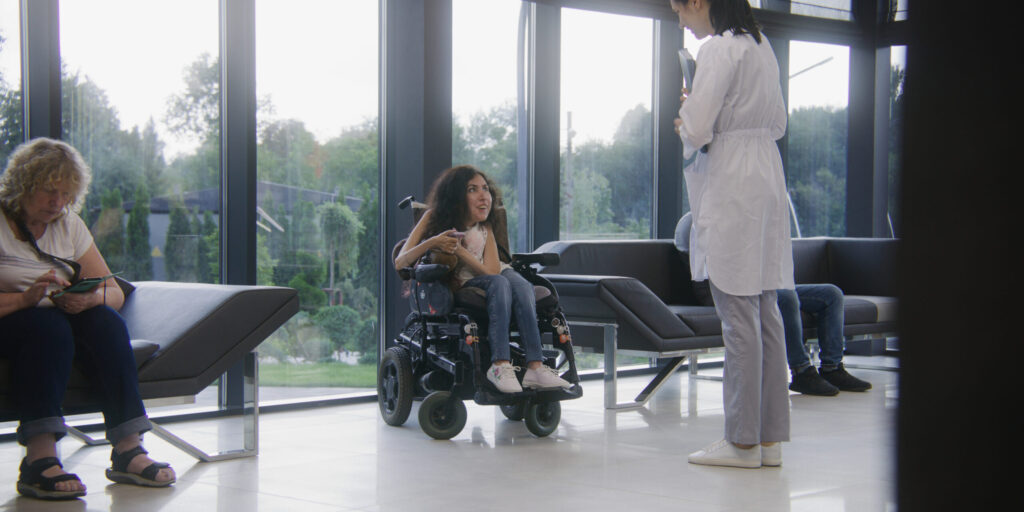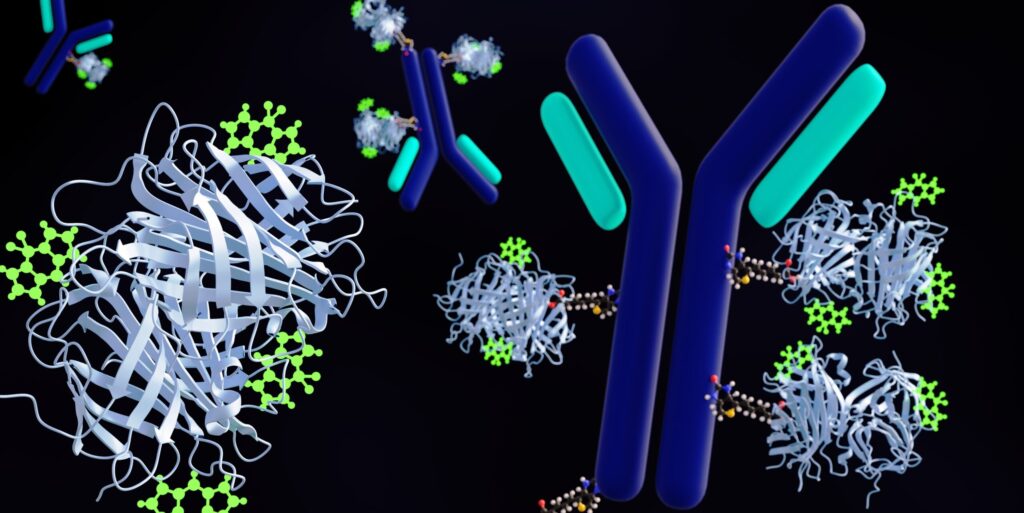
Behind the Drug: Risdiplam (Evrysdi) for SMA
By Maggie Callahan | Thursday, July 31, 2025
Spinal muscular atrophy (SMA) is a rare genetic disease affecting 1 in 11,000 live births in the United States. SMA is an autosomal recessive condition, meaning that a person with the condition receives two copies of the mutated SMN1 gene, one from each parent.
The SMN1 gene is responsible for making SMN protein, which promotes normal development of motor neurons. Motor neurons are cells in the spinal cord and brain with long nerve fibers that connect to muscles and tell the muscles when to contract. Humans have a “back-up” gene called SMN2, which produces only a small amount of functional SMN protein, but not enough to fully support motor neuron development and function. People with SMA are born with the SMN2 gene, but they may have fewer copies of it. Fewer copies mean less SMN protein and more pronounced symptoms.
There are four main types of SMA. Type 1 (SMA1) is the most severe and most common form. Symptoms are apparent at birth or within the first six months of life and result in progressive muscle weakness that leads to life-threatening complications if not treated. SMA types 2, 3, and 4 are less severe and correlate with later onset of symptoms than SMA1.
“Without treatment, babies with SMA1 never achieve motor skills such as sitting or rolling over, and they typically die before their first or second birthday because of complications such as breathing difficulties,” explains Richard Finkel, MD, Director of the Center for Experimental Neurotherapeutics at St. Jude Children’s Research Hospital.
Just a decade ago, there were no approved treatments for SMA. But since 2016, three therapies have been approved by the US Food and Drug Administration (FDA) to treat the disease: nusinersen (Spinraza) in 2016, onasemnogene abeparvovac-xioi (Zolgensma) in 2019, and risdiplam (Evrysdi) in 2020.
Here, we’ll explore how Evrysdi went from concept to approval.
What is Evrysdi?
Evrysdi is an oral medication that works by helping the SMN2 gene produce more full-length SMN protein to support and protect motor neurons. This helps improve muscle strength and function in people with SMA.
Evrysdi is FDA-approved for people with SMA at all ages, and it has also been tested in utero. It is taken by mouth in liquid or tablet form.
Early research and background work
MDA’s investments in SMA background research — about $50 million — helped lay the groundwork for this drug. This funding has supported 200 SMA research programs and trained 24 young SMA investigators, helping them forge their paths as independent researchers.
“From funding research in 1987 that mapped the gene for SMA to supporting the pivotal mouse models in 2002 that identified which tissues are affected by SMA, MDA’s support of SMA research was essential for the future development of SMA drugs like Evrysdi,” says Sharon Hesterlee, PhD, MDA’s Interim President and CEO.
2009: The development of Evrysdi began during investigational research by pharmaceutical company PTC Therapeutics. The company set out to develop a small-molecule drug that could be administered orally, rather than by lumbar puncture or intravenous (into the vein) administration, as is the case with other approved SMA drugs.
2011: Receiving financial support from the SMA Foundation, PTC partnered with Switzerland-based pharmaceutical company F. Hoffmann-La Roche AG (Roche) and created an experimental drug called RG7800.
2014: RG7800 moved into human clinical trials, and children treated with RG7800 showed a positive clinical response. However, as researchers tested the drug in animals to determine toxicity levels and safety thresholds, they discovered a serious side effect: irreversible damage to the retina, the light-sensitive tissue at the back of the eye. This prompted researchers to pause the study in 2015.
“This created some disappointment in the community, because doctors were seeing their patients getting better.” Dr. Finkel says. “While you don’t like to stop a drug that’s working, Roche did the responsible thing to pause and investigate the retinal toxicity.”
Ultimately, researchers determined that the risk was too great, so Roche permanently halted the clinical development of RG7800.
Improving and refining
2016: After carefully studying RG7800 and how it was causing retinal damage, researchers made adjustments and developed a second drug called RG7816 — the drug now known as Evrysdi.
Through numerous clinical trials, this drug was tested in a variety of trial participants with SMA. Genentech, a member of the Roche Group, managed the US-based clinical development and regulatory submissions to the FDA.
“We actively ensured that Evrysdi’s clinical trial program was the most inclusive in SMA, including patients who had different levels of disease severity and functional ability, both ambulatory and nonambulatory patients, those with and without scoliosis (mild to severe), and those with and without prior disease-modifying treatment,” says Sheila Seleri, MD, PhD, Executive Medical Director and Therapeutic Area Lead, Neurological Rare Diseases, at Genentech.
Clinical trials
The clinical trials included:
2016: SUNFISH, a two-part trial involving 231 participants, ages 2 to 25 years, with later-onset SMA (types 2 and 3). Participants were randomly assigned to groups receiving the drug or a placebo. After 12 months, patients showed improvements in motor function and upper limb function.
2016: FIREFISH, an open-label (all participants take the drug), two-part study involving infants ages 2 months to 7 months with SMA1. After 12 months of treatment, 29% of infants could sit without support for at least 5 seconds. At the 24-month mark, 61% achieved this milestone. Five-year data showed that 91% of treated children were alive, with 81% not requiring permanent breathing assistance.
2017: RAINBOWFISH, an open-label study assessing infants treated before 6 weeks of age who were not yet showing signs of SMA. These babies were primarily identified by newborn screening or by positive family history, meaning the parents already had a child with SMA and knew the infant was at risk. After 12 months, 81% of infants could sit without support for at least 30 seconds. At 2 years, all children could swallow and eat orally, with none requiring permanent breathing assistance.
2019: JEWELFISH, an open-label study involving 174 participants, ages 1 to 60 years, who had received prior SMA treatments. Participants were given Evrysdi and monitored for two years. Evrysdi was well-tolerated, and no new safety concerns were identified. Additionally, results showed that Evrysdi increased SMN protein levels and stabilized motor function over the two years.
2020: Evrysdi received FDA approval in August.
The clinical trials included extensive testing to confirm that retinal toxicity was not a side effect of this drug.
“The results showed an extremely favorable safety profile — so much so that since the drug was FDA approved, there’s actually no requirement or even suggestion to do any monitoring,” Dr. Finkel says. “That’s very unusual for drugs treating the nervous system. Usually, you have to check at least blood counts and chemistry values for things like liver and kidney function and monitor them. But the label for Evrysdi doesn’t indicate any requirement, or even suggestion, to do that. There’s also no recommendation for eye monitoring. And so far, that seems to be holding up very well.”
The clinical trial data also highlights the importance of early intervention. “In SUNFISH and FIREFISH, the results showed that the babies with the more severe form, SMA1, actually responded to a greater degree than the older children with SMA2. It highlighted that restoring this SMN protein early in life seems to have more impact than in older children or adults,” Dr. Finkel says. This finding confirms the importance of newborn screening and early intervention in children born with SMA.
Groundbreaking treatment
Remarkably, Evrysdi has been successfully used prenatally. In late 2022 and early 2023, Dr. Finkel administered Evrysdi to a patient who had previously lost a child to SMA. During her next pregnancy, she opted for genetic testing via amniocentesis, which revealed that the fetus lacked both copies of the SMN gene. Given the family history and additional genetic findings, this result strongly suggested the baby would be born with SMA1.
Knowing this, the patient opted to start taking Evrysdi in the third trimester in the hope that it would help her baby.
Administering Evrysdi to the pregnant woman was not an easy decision for Dr. Finkel. “I conferred with the head of our ethics team at St. Jude, and I had to get intimately familiar with the FDA guidance for administering any sort of investigational drug in a pregnant woman, because there would be two patients involved — the mom and the fetus,” he says. “Next, I reached out to Roche and said, ‘Is this a crazy idea? Do you have any safety information to say that this is safe and likely to provide any additional benefit, rather than waiting until the baby is born to start treatment?’ Roche replied that it did have abundant data from animal models.”
The researchers were confident that Evrysdi would pass through the placenta, meaning if the mom took it, the drug would reach the fetus. They also had data on dosing, so they could give an amount that would be adequate without risking overdose.
The baby continued to receive Evrysdi after birth. Now, at nearly three years old, the child has presented no symptoms of SMA. Although the baby was born with other abnormalities, doctors believe they developed in utero before the mother began taking Evrysdi. “Currently, we don’t see any symptoms of SMA from our exams and different tests that we’ve performed, which is favorable,” says Dr. Finkel. Within the past year, several other babies with SMA have been treated prenatally with Evrysdi.
Daily impact
Evrysdi has proven to be a game-changer for many people living with SMA. For example, Dana Carpenter of Austin, Texas, who lives with SMA2, was drawn to the oral administration method and started taking Evrysdi in October 2020 when her strength began to decline. Since then, her stamina has increased, her swallowing feels stronger, and she has been able to drive her power wheelchair again.
“Having that independence back has been life-changing,” she says. “I feel as if my outlook on life has gotten brighter. I have peace of mind that I am doing something to slow the progression of my disease and taking control of my life in a way that was not afforded to me in the past.”
For Kenzie, who was born in 2019, combining Evrysdi with the gene therapy Zolgensma has proven to be the ideal combination. She was diagnosed with SMA1 at one week old and started Zolgensma at one month. Just after her first birthday, Evrysdi was approved. At the time, she was standing but not crawling.
“We decided to go ahead and try Evrysdi, and she started crawling a couple of months later. She started walking on her own at about 21 months,” says Sydney Knobel-Graves, Kenzie’s mom. Today, Kenzie continues to thrive, meeting most developmental milestones.
Looking to the future
Researchers continue to learn about Evrysdi through clinical trials and observational studies. For example, as of the time of this writing, a study is examining Evrysdi’s effects on fertility in adult men with SMA, and a clinical trial is further investigating how the body processes Evrysdi in very young babies with SMA.
These findings could deepen the understanding of SMA and potentially inform the development of treatments for other neuromuscular conditions.
“Successfully developing a drug for one neuromuscular disease can spur the development of therapies for other diseases,” says Dr. Hesterlee. “For those living with SMA, it’s incredible that they have treatment options, allowing them to see which drug makes the most sense for them. All of the drugs, Evrysdi included, have made an impact on the futures of those living with SMA and have potential impacts beyond SMA.”
Next Steps and Useful Resources
- Download MDA’s Spinal Muscular Atrophy disease fact sheet.
- Read more about the science behind SMA treatments in Behind the Drug: Nusinersen (Spinraza) for SMA.
- Visit the Quest Media content library to find more stories about SMA and the individuals and families who live with this neuromuscular disease.
- Stay up to date on Quest content! Subscribe to Quest Magazine and Newsletter.
TAGS: Clinical Trials, Drug Approval, Drug Development, Featured Content, Newborn Screening, Research, Research Advances
TYPE: Blog Post
Disclaimer: No content on this site should ever be used as a substitute for direct medical advice from your doctor or other qualified clinician.




